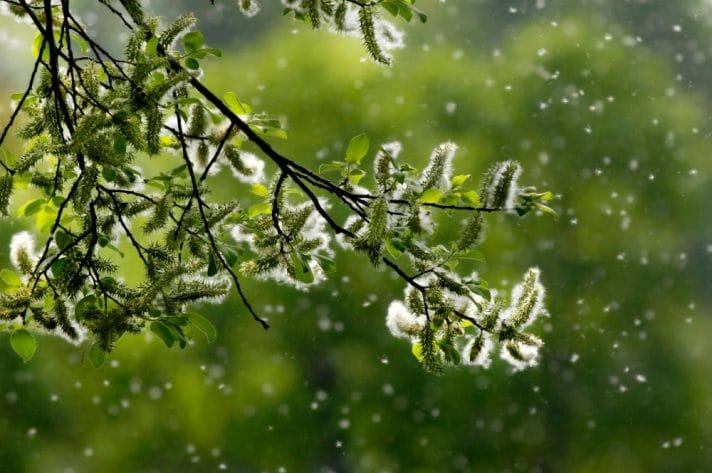Understanding Pollen: Weather, Climate, and Their Impact
Pollen, often seen as an annoyance during allergy season, plays a crucial role in the natural world. Its significance extends beyond causing sneezing fits; it’s a vital component in the reproductive process of flowering plants, serving as the carrier of male reproductive cells. However, pollen’s behavior, distribution, and impact are heavily influenced by weather and climate patterns. In honor of the start of astronomical spring, let’s delve into the intricacies of pollen, its importance, and how weather and climate changes affect it, along with the implications for industries, communities, and individuals.

What is Pollen?
Pollen is a fine powder produced by the male reproductive organs of flowering plants, called anthers. It contains the plant’s male gametes, which are necessary for fertilizing the female reproductive cells, or ovules, in the process of sexual reproduction. Pollen grains come in various shapes and sizes, unique to each plant species, and are often dispersed by wind, insects, birds, or other animals.
The Importance of Pollen
Pollen is essential for the survival and proliferation of flowering plants, which form the basis of many terrestrial ecosystems. It facilitates cross-pollination, leading to genetic diversity within plant populations and ensuring the production of seeds and fruits. Moreover, pollen serves as a crucial food source for many insects, including bees, butterflies, and beetles, contributing to the pollination process and the overall health of ecosystems.
Impact on Industries, Communities, and Individuals
Agriculture
Many crops, including fruits, vegetables, and nuts, rely on pollination for successful reproduction and yield. Bees, in particular, play a significant role in pollinating numerous crops, contributing billions of dollars annually to global agricultural output. Therefore, fluctuations in pollen availability or changes in pollinator populations can directly impact crop productivity and food security.
Health
For individuals with pollen allergies, exposure to pollen can trigger allergic reactions, including sneezing, itching, congestion, and respiratory problems such as asthma. Allergy-related healthcare costs, including medications and doctor visits, are substantial and can significantly impact affected individuals’ quality of life during allergy seasons.
Ecosystems
Pollen serves as a critical link in the intricate web of ecological interactions. It sustains diverse plant and animal populations, supporting biodiversity and ecosystem stability. Changes in pollen availability or pollinator behavior can disrupt these delicate relationships, potentially leading to cascading effects throughout ecosystems.
Weather and Our Changing Atmosphere’s Effects on Pollen
Weather and climate patterns play a significant role in determining pollen production, dispersion, and allergenicity. Here’s how:
Temperature
Warmer temperatures can lead to earlier flowering and extended growing seasons for plants, resulting in prolonged periods of pollen release. Additionally, elevated temperatures can increase the production of airborne pollen particles, exacerbating allergy symptoms for susceptible individuals.
Precipitation
Rainfall patterns influence both the timing and quantity of pollen production. Adequate moisture levels are necessary for plant growth and pollen development, but excessive rainfall can wash away pollen grains, reducing airborne concentrations. Conversely, drought conditions may limit plant growth and pollen production, affecting pollination success and ecosystem health.
Wind
Wind plays a crucial role in pollen dispersion, especially for plants that rely on air currents for pollination. Strong winds can carry pollen over long distances, affecting areas far beyond the source plants’ vicinity. This can lead to changes in allergen exposure patterns, with some areas experiencing increased pollen loads while others may see reductions. Such shifts can pose challenges for allergy management and healthcare planning.
Better Prepare with Better Weather Forecasting
Pollen, though often viewed as a nuisance, plays a vital role in ecosystem functioning, agriculture, and human health. Weather and climate factors significantly influence pollen production, dispersion, and allergenicity, with our changing atmosphere exacerbating these effects. Understanding the complex interplay between pollen, weather, and climate is crucial for mitigating the impacts of pollen-related allergies and ensuring the resilience of ecosystems and agricultural systems in a more volatile climate. While more accurate weather data and forecasting can’t change the amount or distribution of pollen, it can at least give insight to farmers and communities into the severity and impact of approaching pollen seasons. With such insight, those in the agricultural industry and other affected industries can make better informed decisions to minimize negative impacts and capitalize on positive opportunities. If you’d like to learn more about how accurate weather forecasting can provide better insight, contact us.

